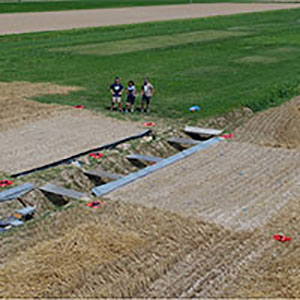Multi-temporal geomorphometric analysis to assess soil erosion under different tillage practices: A methodological case study

Appendix: 116
HTML: 41
All claims expressed in this article are solely those of the authors and do not necessarily represent those of their affiliated organizations, or those of the publisher, the editors and the reviewers. Any product that may be evaluated in this article or claim that may be made by its manufacturer is not guaranteed or endorsed by the publisher.
Authors
Soil erosion is one of the main environmental threats to sustainability and crop productivity in the agricultural sector. In agricultural fields, no-till management is considered a key approach for mitigating soil erosion. The measurement of soil erosion is particularly challenging, especially when surficial morphological changes are relatively small. Conventional experiments are commonly time-consuming and labour-intensive in terms of both field surveys and laboratory methods. On the other hand, the structure from motion (SfM) photogrammetry technique has enhanced the experimental activities by enabling the temporal evolution of soil erosion to be assessed through detailed micro-topography. This work presents a multitemporal quantification of soil erosion, using SfM through uncrewed aerial vehicles (UAV) survey for understanding the evolution of no-till (NT) and conventional tillage (CT) in experimental plots. Considering that morphological changes at the plot scale had millimetre orders of magnitude, it was necessary to minimise SfM errors (e.g., co-registration and interpolation) in volumetric estimates to reduce noise as much as possible. Therefore, a methodological workflow was developed to analyse and identify the effectiveness of multi-temporal SfMderived products, e.g., the conventional difference of digital terrain models (DoDs) and the less used differences of meshes (DoMs), for soil volume computations. We validated the erosion volumetric changes calculated from the SfM outputs with the amount of soil directly collected through conventional runoff and sediment measurements in the field. In this way, we recognised the most suitable estimation method. This study presents a novel approach for using DoMs instead of DoDs to describe the microtopography changes and sediment dynamics accurately. Another key and innovative aspect of this work often overlooked in soil erosion studies, was identifying the contributing sediment surface by delineating the channels potentially routing runoff directly to water collectors. The sediment paths and connected areas inside the plots were identified using a multi-temporal analysis of the sediment connectivity index for achieving the volumetric estimates, using DoMs (e.g., 2213 cm3 for no-till management system - NT and 38155 cm3 for conventional tillage regime - CT during September 2018-June 2020) that showed mild overestimation respect to field measurements results (e.g., 2359 cm3 for NT and 4525 cm3 for CT in the same period). This difference was attributable to other factors (e.g., the soil compaction processes) or variables rather than to photogrammetric or geometric ones. The developed workflow enabled low cos quantification of soil erosion dynamics for assessing the mitigation effects of no-till management that can also be extended in the future to different scales, based on SfM and UAV technologies.
How to Cite

This work is licensed under a Creative Commons Attribution-NonCommercial 4.0 International License.
PAGEPress has chosen to apply the Creative Commons Attribution NonCommercial 4.0 International License (CC BY-NC 4.0) to all manuscripts to be published.

 https://doi.org/10.4081/jae.2022.1279
https://doi.org/10.4081/jae.2022.1279






